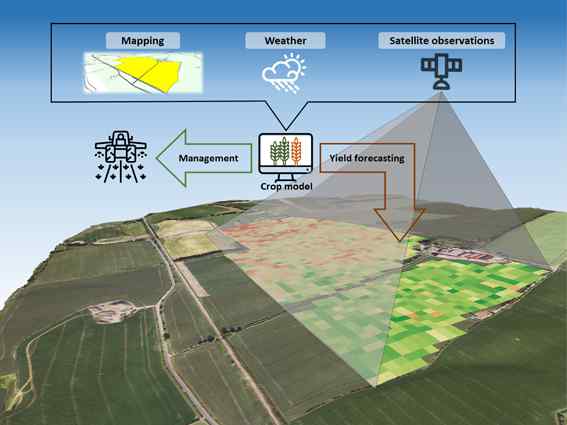Images of climate innovation
Farming from space: sustainability of cropland management
Maps can identify sources of local weather data and Earth observations, which provide estimates of crop canopy development. Observations are combined within a crop model simulating key processes, including photosynthesis, which are used to infer nutrient status and yield. This sub-field scale information supports timely management decisions, such as the more efficient application of agro-chemicals (e.g. nitrogen-based fertilisers).

Digital cartographic data is used to identify sources of available local weather data and Satellite observations (Sentinel-2, European Space Agency). Using machine learning, Satellite observations within the wheat growing season are used to estimate the crop leaf area. The daily weather data is used to drive a process-based crop model whereas the time-series of Satellite-derived leaf area estimates are used to calibrate the model. The crop model used provides a simulation of the cropland ecosystem carbon (C) mass-balance, accounting for processes including photosynthesis and C allocation to the different crop organs (e.g., grain, leaf and roots) as a function of the estimated growth stage. Crop yield - estimated from grain C - is then forecast by driving the model with historic local weather data.
Based on experimental field trials data, recent developments to the crop model structure have included the simulation of leaf nitrogen (N) (see publication: doi.org/10.3390/agronomy11020314). The modelling framework can, thus, generate daily estimates of crop leaf N and yield at the sub-field scale. Field maps of the available leaf N and forecasted yield can support precision agricultural approaches, including variable rate fertiliser and herbicide applications. As well as being able to maximise yield potential and profit, this spatial information can be used to help farmers reduce the use of agricultural chemicals in-line with government policies intended to minimise climate change and promote biodiversity.
Entrant: Andrew Revill , University of Edinburgh
Copyright: Andrew Revill / EDINA Digimap